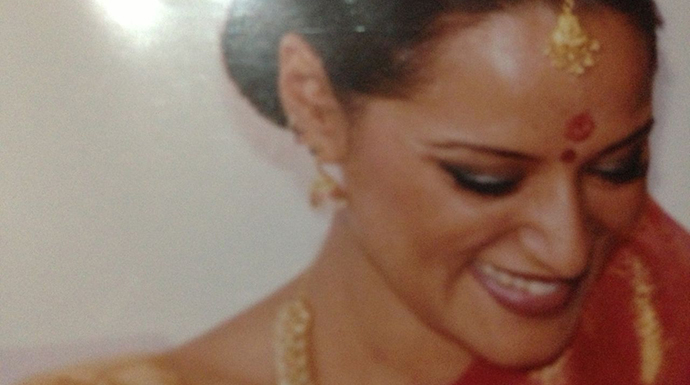Fashion and humility are words that seldom seem to go together. The world of high fashion is oftentimes fraught with the lush surface pageantry, sumptuous galas, exacting rites of passage and unparalleled elitism perhaps heralding back to the fashionable courts of Louis XIV. However in India, if I look closely at the fabric of ‘fashion’, the simplicity, of say, the vaishti, dhoti, lungi or sari, I am always struck by this almost Gandhian frugality that lends itself to these humble yards of ‘uncut’ cloth. In my opinion, the ingenuity and adaptability of this fabric can be traced to the ingenuity and simplicity of its weavers. Ironically, as I write this, the mighty Kumbh Mela is underway outside Allahabad, where blogposts and twitter are going amuck with the visual narrative of men and women who have renounced the materiality of life, save for that little piece of cloth that clings to the loins, as a symbol of repudiation of earthly desire.
When I went traipsing across our country whilst working for Vogue’s Project Renaissance, an assignment that required me to source beautiful hand-woven textiles and send them to international designers like Gucci, Burberry, Christian Louboutin, etc, so that they could craft one-off designs for Vogue, I was humbled by this sartorial journey.
I noticed that whether it was the maheswari weavers in Maheshwar (Madhya Pradesh) or the paithani weavers in Yeola (Maharashtra), the ‘act’ of weaving is as intrinsic to their lives, as is cooking or praying. In fact, in most houses I visited, the weavers handloom (a design marvel of intricate mesh in wood wound with hundreds of colourful threads in meticulous precision) sat side-by-side beds, kitchens or in adjoining rooms, as permanent fixtures. In our urbanized houses, where home-life is meticulously crafted around a plasma screen, in these homes the everyday flurry of daily activities was around their loom. I am acutely aware of this self-defeatist ‘us’ and ‘them’ strain that my article may insinuate. But my intention is to really make myself understand the sociological context within which weaving thrives in our myriad towns and villages; and by doing that, perhaps I can better understand that lifestyle precedes livelihood. Then, and only then, I may indeed have the skills to intervene in this extraordinary world of Indian handicrafts.
So for me, the breakthrough designers of this millennium will be the ones who pose and explore this question: How do I engage two seemingly disparate worlds of creativity—one rural, one urban—into a fruitful relationship?
In fact, the breakthrough for our nation’s creative communities in both spanking metros and frugal villages alike, must come from narrowing this us-and-them divide that has unwittingly made psychological barriers for a productive dialogue, a respectful engagement, and a business that benefits both weaver and designer. How do we participate in each other’s creative world that facilitates an industry of collaboration that is far-reaching, continual and sustainable?
Rajesh Pratap Singh’s work with Orissa ikats and khadi, amongst others, are exemplary in the way he married post-modern silhouettes with traditional hand woven fabrics. Design heavyweights like Tarun Tahiliani, Ritu Kumar and Rohit Bal have always championed the use of Indian textiles. Sonam Dubal treats his collections with the spirit of an academic using indigenous fabrics.
Sabyasachi’s ferocious attachment to native skills and crafts has seen him being one of the strongest exponents of ‘be local to be truly global’. Once, he unhesitatingly said: “Khadi is either associated with politicians, or with the poor. Our country also suffers from the gloss syndrome. Anything that is dull or matte, is not appreciated easily. I wanted to demystify the status of khadi and started creating bridal wear — the ultimate realm of luxury clothing — from the fabric. It creates shock reactions.” Rahul Mishra’s 50’s silouettes dresses in chanderi silks are beautiful, wearable and cool. But we need more, much more involvement from the Indian fashion industry. I am sure in my Indian design fraternity, there are more who need to be mentioned . But in my opinion its not quite enough to impact a nation of weavers and wearers.
I remember a poignant quote by the erudite designer Hussein Chalayan that got me thinking. “When people talk about clothes, they do not talk…in the social and cultural context. They just take them at face value. That’s not something that interests me.” It shouldn’t interest us either. What content is to television, context is to fashion including the ‘fashion’ of handicrafts. The moment we contextualize the living, breathing traditions of our country, the more we will realize the absolute necessity to keep it alive and kicking.
As I debate with Indian and international designers on how Indian crafts can be used in mainstream fashion, this is what I say–my vote, for whatever its worth, goes to those designers who use India’s sartorial traditions and make them super cool. I truly believe fashion can empower a nation, our nation. All we have to do is believe in a simple truism from the mouth of the inimitable Vivienne Westwood, who challenged and changed the fortunes of her nation’s fashion: “In order to do anything original you have to build it on tradition.”
_________________
Bandana Tewari is the Fashion Features Director of Vogue India


Very well said, Bandana. Sustainability and context should be a tenet for us designers of Indian origin.
True that.
Well said and i esp. liked “the gloss syndrome”.
Exquisitely written!
Fantastic insight into Indian textiles and where fashion can grow.
Very well put
thanks for sharing with us!